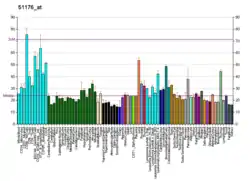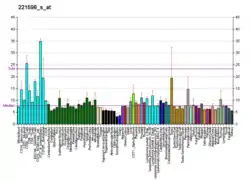MED27
Mediator of RNA polymerase II transcription subunit 27 is an enzyme that in humans is encoded by the MED27 gene.[5][6] It forms part of the Mediator complex.
| MED27 | |||||||||||||||||||||||||||||||||||||||||||||||||||
|---|---|---|---|---|---|---|---|---|---|---|---|---|---|---|---|---|---|---|---|---|---|---|---|---|---|---|---|---|---|---|---|---|---|---|---|---|---|---|---|---|---|---|---|---|---|---|---|---|---|---|---|
| Identifiers | |||||||||||||||||||||||||||||||||||||||||||||||||||
| Aliases | MED27, CRAP34, CRSP34, CRSP8, TRAP37, MED3, mediator complex subunit 27, NEDSCAC | ||||||||||||||||||||||||||||||||||||||||||||||||||
| External IDs | OMIM: 605044 MGI: 1916225 HomoloGene: 3152 GeneCards: MED27 | ||||||||||||||||||||||||||||||||||||||||||||||||||
| |||||||||||||||||||||||||||||||||||||||||||||||||||
| |||||||||||||||||||||||||||||||||||||||||||||||||||
| |||||||||||||||||||||||||||||||||||||||||||||||||||
| |||||||||||||||||||||||||||||||||||||||||||||||||||
| |||||||||||||||||||||||||||||||||||||||||||||||||||
| Wikidata | |||||||||||||||||||||||||||||||||||||||||||||||||||
| |||||||||||||||||||||||||||||||||||||||||||||||||||
| Med27 | |||||||||
|---|---|---|---|---|---|---|---|---|---|
| Identifiers | |||||||||
| Symbol | Med27 | ||||||||
| Pfam | PF11571 | ||||||||
| InterPro | IPR021627 | ||||||||
| |||||||||
The ubiquitous expression of Med27 mRNA suggests a universal requirement for Med27 in transcriptional initiation. Loss of Crsp34/Med27 decreases amacrine cell number, but increases the number of rod photoreceptor cells.[7]
The activation of gene transcription is a multistep process that is triggered by factors that recognize transcriptional enhancer sites in DNA. These factors work with co-activators to direct transcriptional initiation by the RNA polymerase II apparatus. The protein encoded by this gene is a subunit of the CRSP (cofactor required for SP1 activation) complex, which, along with TFIID, is required for efficient activation by SP1. This protein is also a component of other multisubunit complexes e.g. thyroid hormone receptor-(TR-) associated proteins which interact with TR and facilitate TR function on DNA templates in conjunction with initiation factors and cofactors.[6]
See also
References
- GRCh38: Ensembl release 89: ENSG00000160563 - Ensembl, May 2017
- GRCm38: Ensembl release 89: ENSMUSG00000026799 - Ensembl, May 2017
- "Human PubMed Reference:". National Center for Biotechnology Information, U.S. National Library of Medicine.
- "Mouse PubMed Reference:". National Center for Biotechnology Information, U.S. National Library of Medicine.
- Ryu S, Zhou S, Ladurner AG, Tjian R (Feb 1999). "The transcriptional cofactor complex CRSP is required for activity of the enhancer-binding protein Sp1". Nature. 397 (6718): 446–50. Bibcode:1999Natur.397..446R. doi:10.1038/17141. hdl:11858/00-001M-0000-0019-A36A-8. PMID 9989412. S2CID 4405569.
- "Entrez Gene: CRSP8 cofactor required for Sp1 transcriptional activation, subunit 8, 34kDa".
- Dürr K, Holzschuh J, Filippi A, Ettl AK, Ryu S, Shepherd IT, Driever W (October 2006). "Differential roles of transcriptional mediator complex subunits Crsp34/Med27, Crsp150/Med14 and Trap100/Med24 during zebrafish retinal development". Genetics. 174 (2): 693–705. doi:10.1534/genetics.105.055152. PMC 1602071. PMID 16582438.
Further reading
- Roth J, Krause M (1977). "[Relation between manifest bronchial obstruction and bronchial hyperreactivity (author's transl)]". Zeitschrift für Erkrankungen der Atmungsorgane. 146 (1): 12–6. PMID 1020353.
- Gress TM, Müller-Pillasch F, Geng M, et al. (1996). "A pancreatic cancer-specific expression profile". Oncogene. 13 (8): 1819–30. PMID 8895530.
- Malik S, Gu W, Wu W, et al. (2000). "The USA-derived transcriptional coactivator PC2 is a submodule of TRAP/SMCC and acts synergistically with other PCs". Mol. Cell. 5 (4): 753–60. doi:10.1016/S1097-2765(00)80254-3. PMID 10882111.
- Strausberg RL, Feingold EA, Grouse LH, et al. (2003). "Generation and initial analysis of more than 15,000 full-length human and mouse cDNA sequences". Proc. Natl. Acad. Sci. U.S.A. 99 (26): 16899–903. Bibcode:2002PNAS...9916899M. doi:10.1073/pnas.242603899. PMC 139241. PMID 12477932.
- Sato S, Tomomori-Sato C, Banks CA, et al. (2003). "Identification of mammalian Mediator subunits with similarities to yeast Mediator subunits Srb5, Srb6, Med11, and Rox3". J. Biol. Chem. 278 (17): 15123–7. doi:10.1074/jbc.C300054200. PMID 12584197.
- Sato S, Tomomori-Sato C, Banks CA, et al. (2004). "A mammalian homolog of Drosophila melanogaster transcriptional coactivator intersex is a subunit of the mammalian Mediator complex". J. Biol. Chem. 278 (50): 49671–4. doi:10.1074/jbc.C300444200. PMID 14576168.
- Tomomori-Sato C, Sato S, Parmely TJ, et al. (2004). "A mammalian mediator subunit that shares properties with Saccharomyces cerevisiae mediator subunit Cse2". J. Biol. Chem. 279 (7): 5846–51. doi:10.1074/jbc.M312523200. PMID 14638676.
- Ota T, Suzuki Y, Nishikawa T, et al. (2004). "Complete sequencing and characterization of 21,243 full-length human cDNAs". Nat. Genet. 36 (1): 40–5. doi:10.1038/ng1285. PMID 14702039.
- Humphray SJ, Oliver K, Hunt AR, et al. (2004). "DNA sequence and analysis of human chromosome 9". Nature. 429 (6990): 369–74. Bibcode:2004Natur.429..369H. doi:10.1038/nature02465. PMC 2734081. PMID 15164053.
- Sato S, Tomomori-Sato C, Parmely TJ, et al. (2004). "A set of consensus mammalian mediator subunits identified by multidimensional protein identification technology". Mol. Cell. 14 (5): 685–91. doi:10.1016/j.molcel.2004.05.006. PMID 15175163.
- Gerhard DS, Wagner L, Feingold EA, et al. (2004). "The status, quality, and expansion of the NIH full-length cDNA project: the Mammalian Gene Collection (MGC)". Genome Res. 14 (10B): 2121–7. doi:10.1101/gr.2596504. PMC 528928. PMID 15489334.





